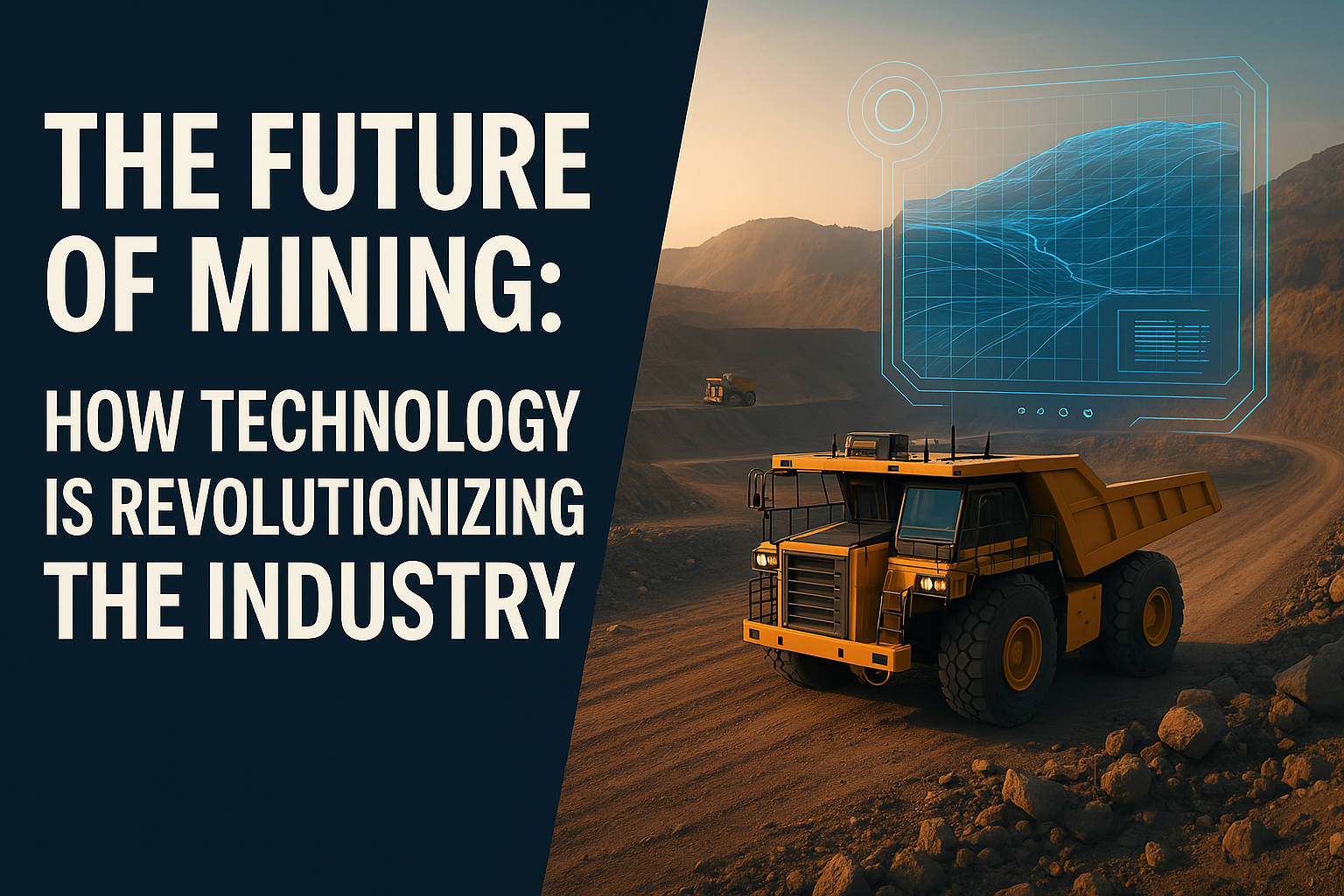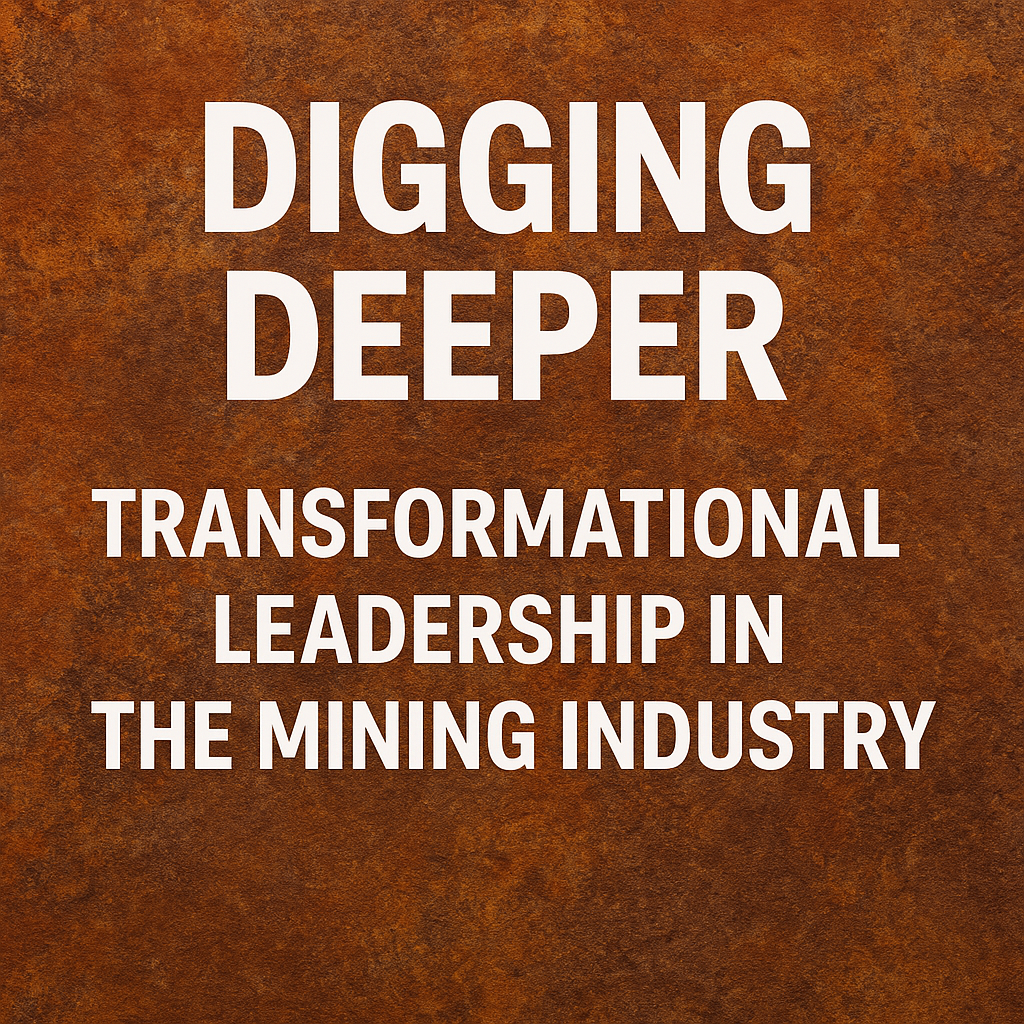THE FUTURE OF MINING: HOW TECHNOLOGY IS REVOLUTIONIZING THE INDUSTRY
Mining has been an essential part of human civilization for thousands of years, providing the raw materials needed for construction, manufacturing, and technological advancements. However, traditional mining methods have often been associated with environmental degradation, hazardous working conditions, and high operational costs. Today, the industry stands at the cusp of a major transformation driven by rapid technological advancements.
Futuristic
mining is no longer just a concept—it is becoming a reality. Emerging
technologies such as artificial intelligence (AI), automation, blockchain, and
green energy solutions are reshaping the way resources are discovered,
extracted, and processed. These innovations are not only improving operational
efficiency but are also addressing critical concerns like worker safety,
environmental sustainability, and resource optimization.
With the
increasing demand for rare earth metals, lithium, and other essential minerals
for electric vehicles, renewable energy, and smart devices, mining companies
are under pressure to adopt more innovative and sustainable practices. The push
for deep-sea and space mining also signals a future where mineral extraction
extends beyond Earth, opening new frontiers in resource acquisition.
In this
blog, we will explore the cutting-edge advancements that are shaping the future
of mining, from AI-driven exploration to autonomous machinery and
environmentally friendly mining solutions. The future of mining is smart,
efficient, and sustainable—let’s dive into the technologies making it happen.
1. AUTONOMOUS MINING EQUIPMENT
Automation
is transforming mining operations, making them safer and more efficient.
Companies are increasingly turning to autonomous mining equipment to minimize
human involvement in hazardous tasks, reduce operational costs, and improve
productivity.
Self-Driving Haul Trucks
One of the
most significant advancements in autonomous mining technology is the use of
self-driving haul trucks. These massive vehicles, equipped with GPS, LiDAR, and
AI-driven navigation systems, can transport tons of ore and minerals across
mining sites without human drivers. These fleets of autonomous trucks operate
24/7, minimizing accidents, and increasing efficiency.
Self-Driving
Haul Truck
Robotic Drilling Systems
Automated
drilling systems are revolutionizing mineral extraction. These systems use
advanced sensors and AI to optimize drill patterns, reduce waste, and increase
precision. For example, Sandvik’s AutoMine system and Epiroc’s autonomous drill
rigs enable remote-controlled or fully autonomous drilling, eliminating the
need for human operators in high-risk environments.
Robotic
Drilling Systems
Remote-Controlled Loaders and
Excavators
Excavators
and loaders are now being equipped with remote control and semi-autonomous
capabilities, allowing operators to control them from safe locations. This
reduces exposure to dangerous working conditions, such as unstable ground or
toxic environments. Some advanced systems, like Komatsu’s Autonomous Haulage
System (AHS), integrate smart algorithms to analyze terrain conditions and
adjust excavation techniques in real time.
Remote-Controlled
Loaders and Excavators
Image
credit: Caterpillar
Underground Automation for
Safety and Efficiency
Underground mining has traditionally been one of the most hazardous sectors of the industry. However, automation is changing that. Autonomous underground loaders and drill rigs can navigate tunnels, detect potential hazards, and operate in extreme conditions without human intervention. This enhances worker safety while increasing operational efficiency.
2. ARTIFICIAL INTELLIGENCE & MACHINE LEARNING
Artificial
intelligence (AI) and machine learning (ML) are transforming the mining
industry by improving efficiency, reducing costs, and enabling smarter
decision-making. These technologies are being used in various aspects of
mining, from mineral exploration and predictive maintenance to automated processing
and real-time data analytics.
2.1 AI
in Mineral Exploration: Smarter and Faster Discoveries
Traditionally,
mineral exploration has been a time-consuming and expensive process that relied
heavily on geological surveys and manual sampling. However, AI and ML have
revolutionized this field by analyzing vast amounts of geological, geophysical,
and geochemical data to identify potential mining locations.
a. Geological Data
Analysis: AI
algorithms can process satellite imagery, historical mining data, and rock
composition to predict the presence of valuable minerals. Companies like
KoBold Metals use AI-driven models to locate untapped mineral deposits
more accurately.
b. Geospatial Mapping: Machine learning enhances
geospatial analysis by recognizing patterns in complex geological
formations, reducing exploration time and costs.
c. AI-Powered Drilling Recommendations: AI can suggest optimal drilling locations based on real-time data, increasing the success rate of exploratory drilling operations.
2.2 AI
Predictive Maintenance: Reducing Downtime and Costs
Mining
operations rely on heavy machinery that must function efficiently to prevent
costly downtimes. AI-driven predictive maintenance systems use sensor data and
machine learning models to detect potential equipment failures before they
occur.
a. Real-Time Monitoring: Sensors collect data on
temperature, vibration, and wear and tear, which AI analyzes to predict
breakdowns.
b. Automated Alerts: AI systems notify
maintenance teams when equipment requires servicing, preventing unexpected
failures and costly delays.
c. Optimized Equipment Usage: AI-driven insights help mining companies extend the lifespan of expensive machinery, reducing operational expenses.
2.3 AI-Driven
Process Automation: Enhancing Efficiency
Machine
learning is being integrated into mining operations to automate decision-making
and optimize resource utilization.
a. Smart Ore Sorting: AI-powered ore sorting systems
use sensors and machine learning to separate high-value ore from waste
rock, reducing processing costs and environmental impact.
b. Automated Drilling and
Blasting: AI
models calculate the optimal blast design for maximizing ore recovery
while minimizing waste and environmental impact.
c. Real-Time Decision Making: AI systems analyze incoming data from mining sites to make instant operational adjustments, improving productivity.
Digital
Geology and Machine Learning
3. Sustainable & Green Mining Technologies
As the
global demand for minerals and metals increases, so does the pressure on mining
companies to adopt environmentally sustainable practices. Traditional mining
operations have long been criticized for their environmental impact, including
deforestation, water pollution, and greenhouse gas emissions. However, the
industry is undergoing a significant transformation with the rise of
sustainable and green mining technologies. These innovations aim to reduce the
ecological footprint of mining while maintaining efficiency and profitability.
3.1 Eco-Friendly
Mining Equipment: Reducing Carbon Emissions
One of the
biggest environmental challenges in mining is the heavy reliance on fossil
fuels for machinery and transportation. To address this, companies are shifting
towards electric and hydrogen-powered mining equipment.
a. Electric Mining Trucks and
Loaders: Companies
like Caterpillar, Komatsu, and Sandvik have introduced electric-powered
haul trucks and loaders that significantly reduce carbon emissions. These
vehicles operate on rechargeable lithium-ion batteries, eliminating the
need for diesel fuel.
b. Hydrogen-Powered
Machinery: Some
mining firms are investing in hydrogen fuel cell technology to power
trucks and heavy equipment, offering a cleaner alternative to fossil
fuels.
c. Autonomous and Energy-Efficient Machines: AI-powered equipment optimizes routes and operations, reducing fuel consumption and minimizing emissions.
An
electric mining truck operating in an eco-friendly mining site
3.2 Water
Conservation and Management: Reducing Water Waste
Mining
operations require vast amounts of water for mineral processing, cooling, and
dust suppression. However, new technologies are making it possible to recycle
and use water more efficiently.
a. Dry Processing Methods: Some companies are adopting
dry separation techniques that eliminate the need for water in ore
processing. This reduces water consumption and prevents contamination of
local water bodies.
b. Water Recycling Systems: Advanced filtration and
water treatment technologies allow mining operations to reuse wastewater,
minimizing freshwater usage.
c. Desalination Plants: In water-scarce regions, mining companies are investing in desalination plants to convert seawater into freshwater for operational use.
A mining
facility using a water recycling system
3.3 Biomining:
Using Microbes to Extract Metals
Biomining
is an innovative, eco-friendly approach that uses naturally occurring bacteria
to extract metals from ores instead of harmful chemicals like cyanide.
a. How It Works: Microorganisms break
down ore material and dissolve metals, allowing for a more environmentally
friendly extraction process.
b. Lower Energy
Consumption: Biomining
requires less energy compared to traditional smelting and refining
processes.
c. Reduced Pollution: Since it eliminates the use of toxic chemicals, biomining minimizes environmental contamination.
3.4 Renewable
Energy in Mining: The Shift to Green Power
The mining
sector is increasingly adopting renewable energy sources to power operations,
reducing reliance on fossil fuels and cutting down on greenhouse gas emissions.
a. Solar-Powered Mining Sites: Mining companies in
sunny regions are installing large-scale solar farms to generate clean
energy. Examples include BHP’s solar-powered nickel mine in Australia and
Gold Fields’ solar plant in South Africa.
b. Wind Energy Integration: Remote mining sites are
using wind turbines to supplement energy needs, reducing diesel generator
dependence.
c. Hybrid Power Systems: Many mines are combining solar, wind, and battery storage technologies to ensure a stable, renewable energy supply.
A
solar-powered mining operation
3.5
Carbon Capture & Rehabilitation: Restoring the Environment
To
counteract mining’s impact on ecosystems, companies are implementing carbon
capture and land rehabilitation programs.
a. Carbon Sequestration: Some mining operations
use carbon capture technology to trap and store CO₂ emissions underground,
reducing their environmental footprint.
b. Mine Site Rehabilitation: After mining operations
conclude, companies restore landscapes by planting trees, stabilizing
soil, and creating wildlife habitats.
c. Eco-Friendly Tailings Management: Tailings (waste material left after mineral extraction) are being repurposed for sustainable uses, such as construction materials or land reclamation projects.
Before and after photo of a reclaimed mining site turned into a green forest
4. Efficiency Deep-Sea & Space Mining: The Frontier of Resource Extraction
As the
demand for rare earth minerals and metals increases, mining companies and
researchers are exploring new frontiers beyond traditional land-based mining.
Two of the most ambitious and futuristic approaches to resource extraction
are deep-sea mining and space mining. These
cutting-edge technologies aim to tap into vast, untapped mineral reserves
beneath the ocean floor and beyond Earth’s atmosphere. While both approaches
offer enormous potential, they also present significant technical,
environmental, and ethical challenges.
4.1 Deep-Sea
Mining: Extracting Minerals from the Ocean Floor
The ocean
floor contains vast deposits of valuable minerals, including copper, nickel,
cobalt, and rare earth elements (REEs), which are essential for modern
technology, renewable energy, and electric vehicle (EV) batteries. Deep-sea
mining aims to harvest these resources from three main sources:
Polymetallic Nodules
- These potato-sized rocks rest
on the ocean floor, rich in metals like manganese, cobalt, and nickel.
- Found at depths of 4,000
to 6,000 meters, primarily in the Clarion-Clipperton Zone
(CCZ) of the Pacific Ocean.
- They can be collected without
drilling, reducing geological disturbance.
Polymetallic
nodules scattered across the deep-sea floor
Seafloor
Massive Sulfides (SMS)
- These are mineral-rich
deposits formed around hydrothermal vents on the seabed.
- Contain high concentrations
of copper, gold, silver, and zinc.
- Harvesting SMS requires
cutting-edge underwater robotics and mining vehicles.
Cobalt-Rich
Ferromanganese Crusts
- Found on underwater mountains
(seamounts), containing cobalt, nickel, and rare earth elements.
- Extraction is challenging due to their attachment to hard surfaces.
4.2 Space
Mining: Unlocking Resources Beyond Earth
As Earth's
resources become increasingly scarce, scientists and private companies are
turning their attention to space mining—the extraction of minerals
and water from asteroids, the Moon, and even Mars. The idea of harvesting
extraterrestrial resources may seem like science fiction, but rapid
advancements in space technology are bringing it closer to reality.
Potential
Space Mining Targets
Asteroids:
A Treasure Trove of Rare Metals
Some
asteroids contain gold, platinum, and rare earth elements in
much higher concentrations than on Earth.
Types
of asteroids for mining:
a. M-type (Metallic asteroids): Rich in iron, nickel,
and platinum-group metals.
b. C-type (Carbonaceous
asteroids): Contain
water ice, essential for space fuel production.
c. S-type (Silicaceous asteroids): Contain magnesium, iron, and silicates.
An asteroid mining spacecraft extracting metal-rich resources
The
Moon: A Potential Mining Hub
a. The Moon contains helium-3,
a rare isotope that could revolutionize nuclear fusion energy.
b. Lunar regolith (moon soil) is rich in
silicon, aluminum, and oxygen, which can be used for in-space
manufacturing.
c. NASA’s Artemis Program and private companies like SpaceX and Blue Origin are exploring lunar resource extraction.
A
futuristic Moon mining base with robotic excavators
Mars:
Future Mining Colony?
a. Mars contains iron, silicon,
and water ice, making it a potential long-term mining outpost.
b. Elon Musk’s SpaceX and NASA are researching ways to mine and utilize Martian resources for colonization.
Concept
image of mining operations on Mars
5. Efficiency Blockchain-Smart Contracts: Enhancing Transparency and Efficiency in Mining
The mining
industry is notorious for its complex supply chains, regulatory challenges, and
concerns over ethical sourcing. Issues such as conflict minerals,
illegal mining, fraud, and inefficient record-keeping have plagued the
sector for decades. However, the introduction of blockchain technology
and smart contracts is revolutionizing the way mining companies track
resources, ensure compliance, and optimize transactions.
Blockchain,
a decentralized and immutable ledger, provides greater transparency,
security, and efficiency, making it a game-changer for modern mining
operations.
How
Blockchain is Transforming the Mining Industry
a. Supply
Chain Transparency & Traceability
One of the
biggest challenges in mining is ensuring that raw materials come
from ethical and legal sources. Many minerals, such as gold,
diamonds, cobalt, and coltan, have been linked to conflict zones and
exploitative labor practices. Blockchain technology allows mining companies
to track minerals from extraction to end-user with complete
transparency.
- Immutable Records: Every transaction (from
mining to refining, transport, and sale) is recorded on a blockchain
ledger, preventing fraud or tampering.
- Digital Certificates of
Origin: Blockchain
ensures minerals are sourced from conflict-free and
environmentally responsible mines.
- Real-Time Monitoring: Companies and regulators can track the movement of raw materials in real-time to prevent illegal mining activities.
b. Smart
Contracts for Secure & Automated Transactions
Traditional
mining contracts involve multiple intermediaries, manual paperwork, and lengthy
legal processes, leading to inefficiencies and high costs. Smart
contracts, powered by blockchain, enable automated, self-executing
agreements between buyers and sellers, ensuring trust and reducing
bureaucracy.
- Instant Payments: Smart contracts release
payments automatically when contractual conditions (e.g., successful
delivery of minerals) are met.
- Eliminating Middlemen: Miners, refiners, and
buyers can transact directly without relying on banks or brokers.
- Dispute Resolution: Since blockchain records are immutable, disputes over contract terms or payments can be resolved transparently.
c. Preventing
Counterfeit Metals & Fraud
Counterfeit
precious metals and fraudulent certifications are a major concern in the mining
industry. Blockchain technology ensures that every ounce of gold, silver, or
platinum is verifiable and authentic.
- Digital Asset Tokenization: Each unit of metal can
be tokenized as a unique digital asset, ensuring its authenticity.
- Tamper-Proof Authentication: Blockchain records
prevent duplicate certificates or falsified documentation.
- QR Codes & RFID Integration: Miners and refiners can embed unique blockchain-verified QR codes on mineral shipments to confirm their legitimacy.
d. Enhancing
Regulatory Compliance & ESG Reporting
Governments
and environmental organizations are imposing stricter regulations on mining
companies regarding environmental, social, and governance (ESG)
compliance. Blockchain simplifies compliance reporting by ensuring
accurate, real-time data submission.
- Automated Compliance Checks: Mining firms can
automatically submit blockchain-verified reports to regulators.
- Emission
Tracking: Companies
can log their carbon footprint on the blockchain for accurate
sustainability assessments.
- Worker Safety & Labor Standards: Blockchain records ensure mining operations follow fair labor practices and ethical sourcing guidelines.
e. Tokenization
of Mining Assets: Democratizing Investment
Traditionally,
investing in mining companies required significant capital. However, tokenization allows
mining assets to be divided into digital shares, enabling smaller
investors to participate in the industry.
- Fractional Ownership: Investors can buy small
shares of a mining project through blockchain tokens.
- Increased Liquidity: Tokenized mining assets
can be traded on blockchain-based exchanges, increasing liquidity.
- Decentralized Mining Funds: Companies can raise funds for mining projects by issuing blockchain-based security tokens.
Blockchain
technology
The future of mining is driven by innovation, sustainability, and automation. As industries adopt AI, autonomous equipment, and green technologies, mining is becoming safer, more efficient, and environmentally friendly. With advancements like space mining on the horizon, the industry is set for a transformative era that will redefine how we extract and use Earth's valuable resources.



 Emmanuel Essel Afful
Emmanuel Essel Afful

